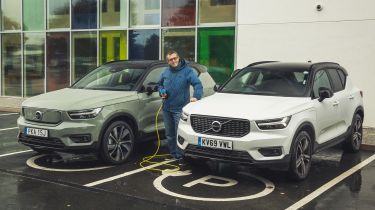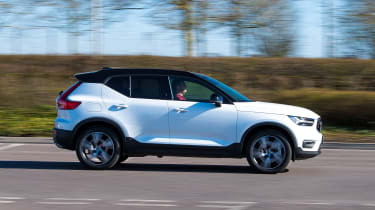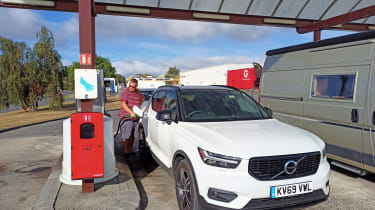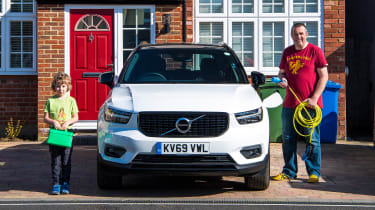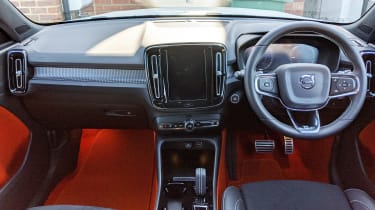Volvo XC40 Recharge T5 R-Design: long-term test review
Final report: Our plug-in Volvo XC40 Recharge T5 has proved a useful step on the way to full electrification

Verdict
The simple truth is that buyers can only make a call on what’s best for them right now. But if spending six months with the Volvo XC40 T5 has taught me anything, it’s that there is greater breadth to this plug-in hybrid’s abilities (and better efficiency) than you might first imagine. And that makes it a very fine transitional option indeed.
- Mileage: 5,830
- Economy: 57.8mpg
We’re all in a Transition Period, apparently. And before you turn the page to get away from another story about Brexit, don’t worry: I’m not going there. Instead, I mean the process of electrifying the cars we drive every day. Depending on where you are in your buying cycle, your current PCP or lease deal, or indeed your own lifestyle, you might be trying to work out exactly how much electricity you can take. Mild hybrid? Plug-in hybrid? Full EV?
That’s what makes the comparison between the two cars you see above so interesting. On the right is our Volvo XC40 Recharge T5, a plug-in hybrid model that we’ve spent six (predominantly locked-down) months with. On the left of the picture is the new XC40 Recharge P8, the pure-electric version of the same model.
First, some conclusions about the hybrid, which arrived just as the first lockdown was kicking in. As a result, this car did fewer miles overall than I would normally rack up – but the number of journeys, almost all of them local, was probably greater.
Used - available now
However, this played to the strengths of the car’s PHEV powertrain, which mixes a small electric motor with a 1.5-litre three-cylinder petrol engine.
Plugging in the XC40 T5 every few days on my home charger allowed me to complete the majority of the car’s mileage on electricity alone – silently, with zero tailpipe emissions and, thanks to an Octopus off-peak EV charging tariff, at a fraction of the cost it would have incurred running a pure petrol alternative.
Now, I reckon many potential ‘transitioners’ already know how well PHEVs can work in this environment – but they might be put off by the idea that they’ll end up with an uneconomical petrol car when they need to push beyond the comfort zone.
This worried me too – not least when I took the XC40 to southern Normandy for a late-summer family holiday – but in my experience, the car was still capable of 45mpg, even on those occasions when I forgot to charge it up and ended up driving around purely on petrol power.
Elsewhere, the XC40 proved to be just about big enough for family life, with a sensible boot and enough room in the rear for my son, even if fitting his car seat was a less-than-appealing process, thanks to the car’s fiddly headrests. The car also showed resistance to squeaks and rattles – all the more commendable on the pock-marked urban roads I often have to travel on.
Even the orange carpets (a design feature from the original concept that I’ve always loved) stood up well to frequent abuse from a seven-year-old’s wet wellies. I have to admit here that I specced the car from the interior upholstery out, though, and the bright fabric is available only in R-Design trim. This, in turn, brought larger wheels than I’d ideally like, adding a slightly brittle edge to the XC40’s ride, which was, for the most part, comfortable enough.
So after six months, would I swap the back-up of that engine for the all-round whizziness of the EV pictured alongside it? Not quite. It’s not that I don’t consider myself ready for pure electric; I’ve happily run EVs before and could do so on a more long-term basis, albeit safe in the knowledge that our main family car is petrol. The P8 Recharge’s range of around 260 miles would be more than enough for my current use, too.
No, it’s the cost involved that would put me off. Volvo has gone in punchy with the P8’s performance, true, but also its pricing. It costs a whopping £59,985, which makes even my £41k hybrid look like a bargain, both on list price and the resulting monthly Benefit-in-Kind tax payments you’d face for running one as a company car.
The car that XC40 PHEV owners might gravitate towards has yet to be launched, I’d argue. It’ll be a pure-electric version but with a single motor, a slightly smaller battery and a list price that’s the right side of 50 grand. It’s coming, probably this year.
Volvo XC40 Recharge T5: second report
French trip shows off efficiency of the Volvo XC40 Recharge T5’s petrol engine
- Mileage: 4,200
- Economy: 56.3mpg
You will, by now, be used to Auto Express testers warning you about the sort of fuel economy you can achieve in a plug-in hybrid if you don’t, well, plug it in. This type of vehicle can save you huge bills on company car tax, but if you don’t actually give it electricity on a regular basis, it can quickly become just an inefficient petrol car.
This issue has been on my mind ever since I took delivery of our Volvo XC40 PHEV, not least because I have recent history of running pure-electric cars, with the resulting drop in fuel bills, and I’m keen to not see the costs leap back up again.
Sure enough, though, the XC40’s hybrid system has proved pretty rudimentary since it arrived. Yes, the car is good for a solid 22 miles on pure-electric power – maybe a little more if driven carefully. But on a longer run, it seems to be utterly desperate to use that battery power up; it appears to deploy this electric energy as quickly as possible and then spends the rest of the journey running on petrol. In an era when every inch of the road network is mapped, I’d expected something a little more intelligent.
Recently, though, I had the chance to push the car’s 1.5-litre, three-cylinder petrol engine-based powertrain properly beyond its suburban comfort zone, and then some. I took it to the south of Normandy, France, in fact, as the McIlroy family deserted the comfort of their front room for what seemed like their first holiday in ages.
The trip to the continent started true to form. As we drove from our home in Berkshire towards the Channel Tunnel, I was able to watch the Volvo’s battery meter heading steadily downwards. And by the time we’d reached the A3 turn-off of the M25, the cells were fully depleted, leaving the 70 miles to Dover, and a few hundred more to Mont St Michel, to be completed on petrol power alone.
As it turns out, though, things aren’t quite as simple as this. As the day progressed, and we made our way along France’s gloriously tolled (and traffic-free) autoroutes, I began to notice how the Volvo does indeed try to stick to electric power, even when the battery says there isn’t any available.
I started freewheeling down sweeping stretches of hillside, then trying hard to eke out the next mile or two on the energy that I’d regained through coasting.
Once we arrived at our campsite, we soon found the chalet had pretty much everything we needed bar an external power point, so the Volvo did the following seven days (and the journey back to the UK) without a top-up from mains electricity.
But here’s the thing: it managed the whole week while returning almost 45mpg, and I don’t think that’s such a bad figure. When you consider that the Volvo can do this but then spend the remaining 51 weeks of the year (or thereabouts) silently pootling around my local roads purely on electricity, it’s not that bad a trade-off. If anything, in fact, it shows just how efficient the XC40’s downsized petrol motor is.
Economy aside, I’ve recently managed to get my smartphone properly hooked up to Volvo’s onboard ecosystem, so I can now control key vehicle functions from the sofa (or anywhere with a data signal). It’s a worthwhile process because, although you can’t control the car’s charging timetable from the dashboard, you can via the app – and that means I can plug it in when I arrive home but, based on my location, schedule it to not actually start taking any electricity from the socket until the small hours.
That, in turn, helps to keep the electricity bill down, because my Octopus Go energy tariff has a special EV-friendly off-peak stint between 00:30 and 04:30, when it costs just 54 pence to top up the XC40’s 10.7kWh battery. That’s not a bad bill for 20-odd miles of motoring – and it helped to make the car’s long-distance efficiency on our trip to France all the more palatable.
Volvo XC40 Recharge T5: first report
The plug-in hybrid Volvo XC40 T5 Recharge has got off to a strong start, thanks to life under lockdown
The world might seem like it’s being held in a freeze-frame at the moment, but when we do all emerge from lockdown, blinking into the sunlight, we’ll find the car industry in a period of real transition. We keep being told we’re going to have to go pure electric. But are we all ready for that?
The answer, of course, is no. And that, in theory, is where cars such as the latest arrival on our fleet come in. Because while I have plenty of experience running EVs, I’ve never tried an extended period in the ‘halfway house’ that’s supposed to help us move from petrol and diesel to that more advanced powertrain: a plug-in hybrid.
So here it is, the catchily named Volvo XC40 Recharge Plug-in Hybrid T5 FWD R-Design. A brief look at the specs shows the car’s tech is nearly as complex as its name.
The Volvo has a 1.5-litre three-cylinder petrol engine that produces 177bhp and 265Nm of torque. Then there’s also an electric motor, which contributes 81bhp, and a 10.7kWh battery that can, in theory, power the car for up to 28 miles of zero-emissions running. It’s all transferred to the road via a seven-speed automatic gearbox and front-wheel drive.
Volvo is certainly on a roll at the moment, but on paper at least the XC40 looks ambitiously priced. The range starts from £25k, which is reasonable for such a funky premium SUV. But the Recharge carries a premium of £15,000 over the entry-level car. Our car’s options – a trio of bundles, plus a rear parking camera, a powered driving seat, the dramatic Lava Orange carpet and premium metallic paint – take that figure to a fairly eye-watering £44,840.
I’ve been a slave to fashion with the carpet and paint, I’ll admit (the floor lining was stunning on the original show cars from Volvo, so I’ve always wanted to put it to the test on an everyday basis). And I chose the Winter pack because the car was originally scheduled to turn up in February. But there are a couple of features that I’ve had to tick options boxes for that I think should come as standard.
The first is smartphone integration. Volvo’s portrait-layout infotainment system is decent enough (although no longer standout brilliant in a fast-moving market), but I’ll rely heavily on Android Auto to navigate the worst traffic when my regular commute to London restarts. In this day and age, on a car costing £40k, it’s laughable that Volvo charges £300 for this functionality (it comes as a pack with Apple CarPlay as well).
The second feature is powered child locks. To my mind at least, Volvo is still a brand with safety at its heart – so I’m surprised that this sort of family-friendly tech comes with an £85 charge. It’s small change amid the overall figure, though, and probably wouldn’t make a big difference on monthly payments or company car bills.
And the second of those ownership methods is, of course, this XC40’s star turn. Here’s a £40,000 car that will cost 20 per cent tax-payers just £3,186 over three years as a company car – or barely £90 a month. And even 40-per centers will pay an average of just £177 a month.
But all of this only makes sense – and delivers low running costs to the actual user beyond their company car tax bill – if you plug in the XC40 wherever possible. So that’s what I’ve been doing during lockdown, rendering the combustion engine completely irrelevant as we force the car into its EV mode for the weekly trip to the shops to pick up essential groceries. This has the added benefit of keeping me away from petrol pumps.
I have an Octopus Go tariff – a bit like Economy 7 but for cars – and if I chuck a full battery’s-worth of electricity in overnight, I have more than enough for all of my local journeys for just 53 pence.
On that basis, the XC40 is already working well, and the electric motor has just about enough shove to cope with the car’s increased weight when pulling away from traffic lights and junctions.
Of course, I’m keen for the lockdown restrictions to be lifted so I can start experimenting with the Volvo’s abilities over longer journeys – playing with the different modes to see which gives me the best efficiency over my commute. It can’t come quickly enough, in so many ways.
| Model: | Volvo XC40 Recharge T5 Plug-in hybrid R-Design |
| On fleet since: | March 2020 |
| Price new: | £41,080 |
| Engine: | 1.5-litre petrol plus e-motor, 177+81bhp |
| CO2/tax: | 48g/km/£140 |
| Options^: | Lava Orange carpet (£175), child locks (£85), power driver’s seat (£450), reversing camera (£375), smartphone integration (£300), premium metallic paint (£850), Convenience Pack (£600), Winter Pack (£500), Intellisafe Surround (£600) |
| Insurance*: | Group: 29 Quote: £480 |
| Mileage: | 5,830 |
| Economy: | 57.8mpg |
| Any problems? | None |
^All options and prices correct at the time of delivery
*Insurance quote from AA (0800 107 0680) for a 42-year-old in Banbury, Oxon, with three points

